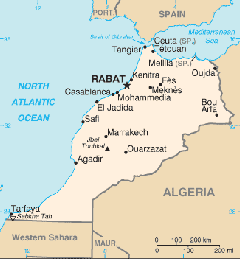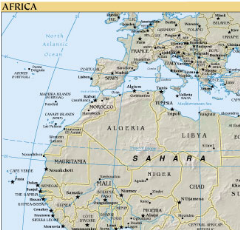

 |
 |
|
| CIA World Factbook entry for Morocco |
Morocco is a somewhat large, geographically diverse country located in north west Africa. The name used by Moroccans for the country is Maroc. Because Morocco, Algeria, and Tunisia are the western edge of the arabic world, these countries are sometimes collectively referred to as Maghreb, which can be translated as "the sunset" or "the west".
The native people of Morocco are Berbers, who have over the centuries been ruled by, or influenced by, the Phoenicians, Romans, Vandals, Eastern Arabs, Spanish, and the French. By 700 AD, The Islamic empire, spreading from the middle east, had expanded to include Morocco. From 700 AD, to 1912, Morocco was largely independent, under the rule of a succession of royal families. In the early 1660s, Moulay ar-Rashid unified much of what is now Morocco. His rule was followed by Moulay Ismail from 1672 to 1727 who ruled with an iron fist and under his rule, the Barbary Pirates were a feared naval force in Africa and Europe. In 1777, Sultan Sidi Mohammed Ben Abdullah was one of the first world rulers to recognize American Independence from Britain. Morocco was able to fend off attempts at European control up until the reigns of Moulay Abd al-Aziz and Moulay Abd al-Hafiz in the early 20th century. Political and economic problems in Morocco, combined with European deal making, allowed France to take control of the country through the Treaty of Fes, signed on 30 March, 1912. As part of the European deal making, Spain took control of the north eastern area of the country, and the Western Sahara. Tangier, on the straits of Gibraltar, was declared an international city.
As a French protectorate, Morocco benefited from investment in infrastructure and education. But this rule was not without dissent. Throughout the next 40 some years, the French faced varying degrees of resistance, both violent and non-violent. In 1956, Morocco was granted independence, and King Mohammed V, heir to the old Alawite dynasty, was declared king. Spain pulled out of most of their territories following the French withdrawal. However, Spain held on to the Moroccan mainland enclaves of Ceuta, Melilla, and a few disputed islands, which they control to this day.
Mohammed V ruled the country til his death in February 1961, when he was succeeded by his son, Hassan II. Hassan II ruled the country until his death in July 1999. His rule was marked by periods political and economic reform, interspersed with crackdowns on political dissent and political imprisonment of dissidents. Hassan II was succeeded at his death by his US educated son, Mohammed VI. Mohammed VI has improved upon the political and economic reforms of his father.
Today, Morocco straddles the developed and developing world. While it is more prosperous than most "third world" countries, it is by no means a fully developed industrial country. On one hand, Morocco has a stable government, modern cities, manufacturing, tourism, sufficient food supply, and an international business presence. On the other hand, literacy is a little over 50%, unemployment is high at around 40%, and the average annual wage for farm and factory workers is only around $1000 USD.
Morocco is a geographically diverse country. It contains craggy Mediterranean landscape, Atlantic and Mediterranean beaches, thick cedar forests, rugged and snow capped mountains, and classic Saharan geography complete with sand dunes and blackrock deserts. The coldest city in Africa, Ifrane, lies in an alpine like setting in the Atlas mountains, complete with evergreen forest and ski resorts (and monkeys).
Morocco is a somewhat large country, the size of which depends on who you listen to. Morocco has staked claim to the region of Western Sahara, which it occupied in 1975 after the Spanish abandoned that area. This territorial claim is not universally recognized however, and discussion of this claim is an area that is said to be somewhat touchy in the mostly independent Moroccan press. Though Western Sahara is desolate, and sparsely populated, it does have valuable mineral deposits, including possible oil reserves.
Morocco proper is just under 447,000 sq. kilometers, which is a little larger than the state of California. Including the 266,000 sq. kilometers of the contested Western Sahara region, Morocco is a little larger than Texas. For a European example, France is 547,000 sq. kilometers in size.
The official language of Morocco is Arabic. The dialect of Arabic spoken there is different from the more formal version spoken in the Middle East. Because of their colonial history, French is commonly spoken, and is the language of business in the country. Road and business signs are typically in both Arabic and French, though in more rural areas this is not always the case. English is also commonly spoken. Across the Atlas mountains in the south of the country, the traditional language is Berber. And due to Morocco's proximity to Spain, and the former Spanish control of parts of the country, Spanish can also be a handy language for visitors.
Moroccans have a talent with language, and it is not unusual to find Moroccans who know at least a smattering of 3 and 4 languages.
The official currency of Morocco is the Dirham (Dh), sometimes referred to as the Moroccan Dinar. In tourist areas, some shops may accept US dollars or Euros. At the time of this writing, the exchange rate between Dirham and US Dollars was approximately 8.9 Dh - 1 USD. It is against the law to export large sums of dirham, so it can be difficult to obtain dirham outside the country. You are best off waiting till arriving in the country to exchange currency. US ATM and credit cards work in Moroccan ATM machines, which are common in the larger cities. In smaller rural cities, ATMs are still available, but less common. Most businesses we encountered were cash oriented, and did not readily accept credit cards. This included our rental car company, and most of the smaller hotels we stayed at.
Morocco is a moderate Islamic country. Islam is the official state religion, and some 98% of the country's population is Muslim. King Mohammed VI and the Alawite dynasty owe some of their claim of authority to the fact that they are direct male line descendants from the prophet Mohammed. For the visitor, the ubiquitous mosques and the 5 times daily call to prayer will serve as reminders of the role of Islam in the country. In spite of the importance of Islam to the country, Morocco is considerably more modern/moderate than some other prominent Islamic countries such as Saudi Arabia or Iran. Christians and Jews are legally free to worship openly (Jews are said to face discrimination however). Morocco does not impose sharia / koranic style punishments such as stonings, or amputating the hands of thieves. Alcohol is available, and there are locally made beers and wines. And the city of Tangier has gambling and a casino. While the role of and treatment of women may rile American sensibilities, Moroccan women do attend school, hold jobs, drive, and appear unveiled in public. Public dress for Moroccan women ranges from typical Western jeans and t-shirts for many young women, to full black burquas for traditional / fundamentalist women.
Moroccans are known for their hospitality and Arabic culture is known for expressive emotions and close relationships. Public displays of affection between men and women however are rare. But it is common to see men holding hands with other men, or women walking hand in hand with other women. Greetings between friends often include kissing on the cheeks. Even among strangers, it is common to see men putting an arm around another mans shoulder while talking. Strangers are often invited to have mint tea and share conversation. And Moroccans find requests for assistance to be culturally difficult to refuse.
For tourists, this can be quite helpful. During our trip, we would hit an unfamiliar town, often after dark, needing to find a hotel or restaurant. We had no trouble getting directions or restaurant tips. One shop owner left his stall during the middle of the day to walk us to a restaurant we were having difficulty finding. Another time our group was hankering for a western style meal, and was willing to make hamburgers for us even though that wasn't on the menu.
This hospitality can at times be a mixed blessing. Due to the high unemployment rate in Morocco, in tourist areas there are any number of people soliciting to be a guide or to show you to shops or restaurants. And a tourist showing a moment of indecision can be inundated with offers of help. The payoff for the guide is typically 5, 10, or 20 dirham, and the ability for them to steer customers to a friend or relative's business. If you need assistance, pick someone who seems to speak your language, and be grateful for the help. If you don't need the assistance, polite but firm replies of "La Shakran" or "Non Merci" (Arabic or French for 'no thank you') are usually sufficient to discourage the attention.
While an American might think nothing of passing through a room and acknowledging acquaintances with little more than a nod of the head, this would be considered to be quite rude in Morocco. When entering a room in Morocco, a man will greet all the other men present with "Salam a lekum" (peace to you and your angels) and a shaking of hands, followed by placing their hand over their hearts to demonstrate the sincerity of the greeting. Here is where the traveler may find that a little Arabic can go a long way in generating a warm reception.
Proper dress can also help generate goodwill. While tourists wearing tank tops and shorts are not uncommon, this type of clothing is generally considered uncouth for men, and lewd when worn by women. In cities such as Casablanca, men can get by with long walking shorts and t-shirts, where women might be better served by at least capri length pants and short sleeves. The area of the country that you are in influences a tourist's clothing choices. In rural areas or in non touristy sections of cities, it is better to dress more on the conservative side. Whereas in resort areas such as Agadir, dress is said to be less conservative for both men and women, including topless bathing at resort beaches. (We did not however travel to these areas).
Women traveling without men would do well to read up on Moroccan culture, and be prepared for a more chauvinistic society than they may be used to at home. Wearing "revealing" clothing can invite catcalls and propositions if a woman is not accompanied by a man. Attitude and expectations will determine whether or not female travelers enjoy their trip to Morocco.
| Back | Photos and Text Copyright 2004, Andy and Sandy Welter. | Last Updated: April 2004 |